487 Search Results for opportunities
November 13, 2012
by Carole Zangari -
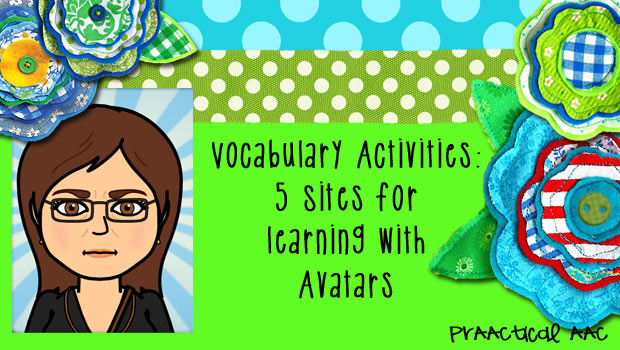
We’re always looking for engaging activities to use to practice words that our AAC friends are learning. For some learners, making avatars can be a great way to do have an authentic reason to use words for body parts and accessories as well as modifiers for size, shape, color, and other things. Plus…Who wouldn’t want an excuse to make a younger, thinner, cuter, or funnier version of themselves?! Here are some sites to check out. Pop Art Pixies: Basic avatar site oriented for girls. Good for using core language, making requests, color & size words. DoppelMe: Easy to use site for making cartoon-like avatars with several opportunities to choose elements, like clothes, hairstyles, and backgrounds. Use words for feelings to select facial expressions. WeeWorld: Another user-friendly site that can be a fun way to use descriptors in making selections to create, dress, and style your avatar. This site’s graphics would... [Read More...]
November 10, 2012
by Robin Parker -
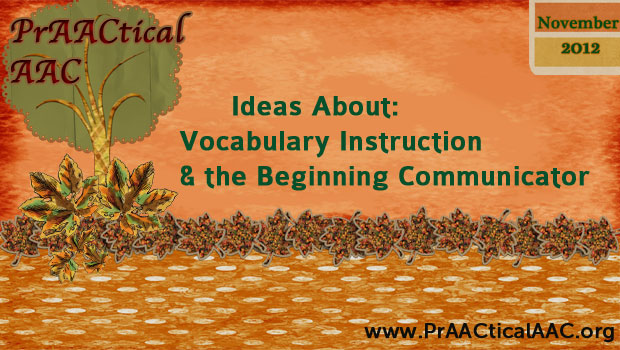
Vocabulary instruction is a topic not often discussed for beginning communicators. As we work with beginning communicators the primary focus is often vocabulary selection for communication displays. This is understandable as the beginning communicator has many needs, but that is no excuse for leaving out vocabulary instruction. Direct vocabulary instruction helps expand broader vocabulary selection options, literacy skills, and world knowledge. With that in mind, see below for vocabulary instruction philosophies, notes, and activities for the beginning communicator. Please let us know about your favorite vocabulary instruction activities. Vocabulary Instruction for the Beginning Communicator: 5 Philosophies Vocabulary instruction involves a systematic TEACHING process. Add vocabulary as an activity on the daily schedule and then have a mini-schedule for the specific vocabulary instruction activities for that day. Carole introduced general steps for vocabulary instruction last week. For the beginning communicator, also apply an errorless learning paradigm. Gradually, add comprehension checks, but... [Read More...]
November 7, 2012
by Carole Zangari -
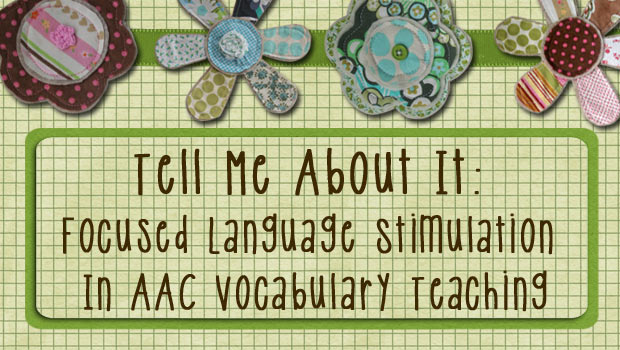
Earlier this month, we introduced a general sequence of how we conceptualize semantic instruction. We promised to elaborate on that. There are two things that I really love about this approach to to vocabulary teaching. The first is that is honors a principle that we know to be true: providing repetition with variety not only helps us reach learners with different strengths, but also gives our AAC learners much-needed practice. The other thing that makes this really work for us is that assessment has an active role but not a central one. Testing takes a backseat to teaching. As we all know, getting accurate assessment information from people who are learning their AAC systems is a huge challenge. Often, our AAC friends don’t have decent test-taking skills so we’re not really testing what we think we’re testing. Just last week I got to see Kristofer, an adorable little fellow who... [Read More...]
November 5, 2012
by Robin Parker -
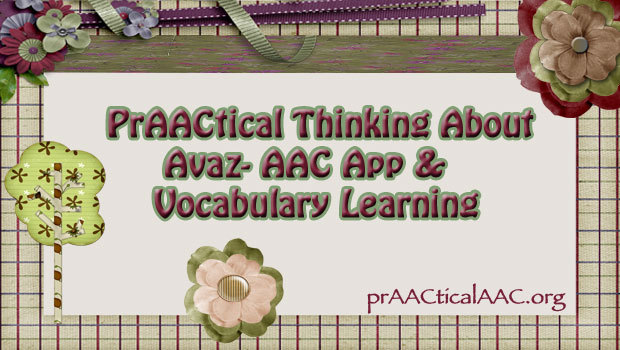
We originally talked about Avaz, the first commercially available AAC app developed in India, back when we introduced PrAACtical AAC in January of 2012. At that time, one of the primary developers, Ajit Narayanan, was recognized by the MIT Technology Review through the prestigious TR35 List, which applauds 35 innovators under 35 years of age. We were congratulating the team at Invention Labs and thinking that they would continue to improve communication for individuals with disabilities throughout 2012. They have succeeded. The Avaz team has worked this year seeking feedback from AAC professionals throughout the world. They have listened and have made many updates to improve the communication and language options of the Avaz App. We thought this was a great time for some follow-up information because many of the modifications and added options relate to vocabulary, which just happens to be our strategy of the month. Pre-loaded vocabulary has... [Read More...]
November 3, 2012
by Carole Zangari -
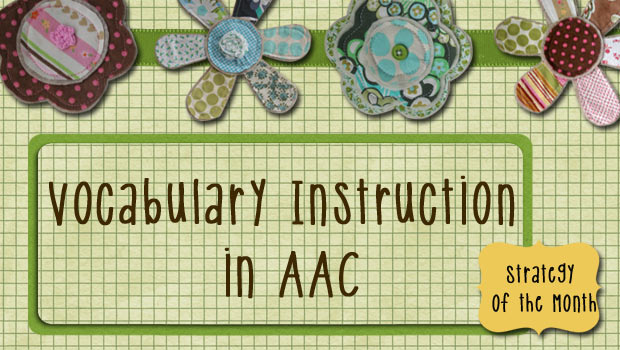
For all of us, the process of how we learn to use words begins with the expression of our own intents. Initially, we use words, pictures, or signs to make our wants/needs known but that soon develops into social exchanges, true conversations, stories, and more. For some of our AAC friends, the path to a rich lexicon can be convoluted and bumpy. Our November Strategy of the Month posts will focus on vocabulary instruction giving both general principles that should guide our teaching and specific considerations for communicators at different levels. As SLPs, we should be champions for a comprehensive approach to semantic instruction in AAC. Much of what we already know for teaching semantics to people who speak can be applied quite nicely to individuals with AAC needs. Certainly some things will need to be adapted, but that’s not the real issue. We’ve noticed that SLPs sometimes forget to... [Read More...]
November 2, 2012
by Carole Zangari -
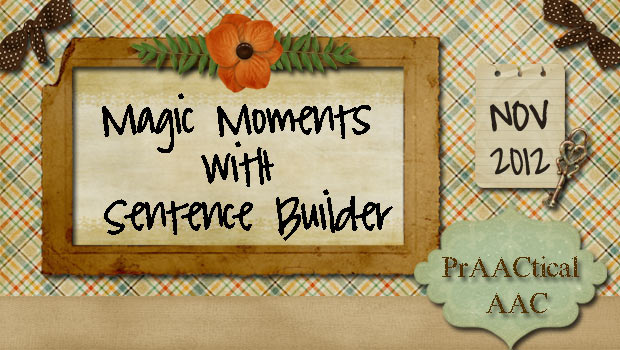
We were lucky enough to snag copies of Sentence Builder by AbiTalk when it was offered for free earlier this year and have had a great time with it. It comes with prepared lessons at two levels and the flexibility to create your own lessons. Here are some ideas for using the ready-made lessons to build language skills in AAC learners. Core Vocabulary: We’re always looking for ways to practice an initial lexicon of basic core words, like I, is, have, and can. These words appear with frequency in Sentence Builder, which makes it a great fit for learners working on that skill. Those of you using this app in a group may find that this offers a great opportunity for differentiating instruction in multi-level groups. Parts of Speech: In AAC therapy, we often focus on the part of speech since that it how many SGDs organize vocabulary. We like... [Read More...]
October 20, 2012
by Robin Parker -

Sometimes saying ‘no’ to the demands of the day actually helps us rejuvenate and allows us to be more productive. Saying ‘no to false information helps us to advocate for ourselves. The ‘no’ topic seems to be trending now. There have been quite a few blog posts and comments about the issue (Just Say No, How and When to Give Your Students A Break). We are so glad that this topic is getting more focus. Of course everyone agrees that ALL people have the right to say ‘no’. But it is not always so simple. There are many types of ‘no’. There is the outright ‘no’, the ‘no’ to more work, the ‘no’ for disagreement, the ultra important ‘NO’ to unwanted touching, and many more. And depending upon how you say ‘no’ is the difference between it being accepted or… NOT. The issue of saying ‘no’ gets more complicated when... [Read More...]
October 3, 2012
by Robin Parker -
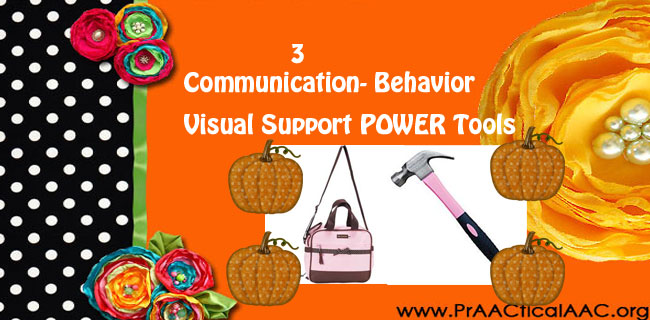
Behavior challenges tend to be a major concern of speech-language pathologists, parents, and educators alike. It is the area that is often most nerve wracking for many professionals and families. But once you get a set of strategies that help you have a plan, most challenging behaviors can be reduced. We like to think of challenging behaviors as opportunities 1: for the learner to practice understanding or expression of communication and language and 2: for facilitators/educators to use behavior strategies or learn new ones. So in order to be best prepared for challenging behaviors, start a Communication-Behavior Strategy Tool Kit. Here some powerful tools that will help ALL learners. 3 Power Tools for Communication & Behavior Choice Boards- helps give a learner power but under our guidelines and boundaries. With choice boards, a student learns more communication while having less power struggles/behavior challenges. Opportunity to teach choice making, expression... [Read More...]
September 2, 2012
by Robin Parker -
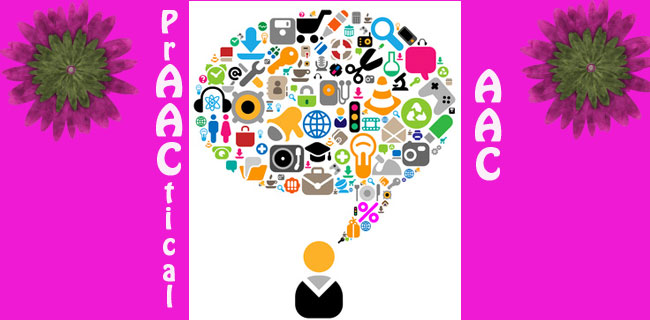
We have recently been surprised (ok, shocked) by the absence of communication supports in educational settings that are supposed to be supporting learners with significant communication challenges. To be even more specific and blunt, the students do not have functional spoken speech. They can’t speak to let you know: what they need, what they don’t need or want, how they feel, what they see, what interests them, what questions they have, what they like and don’t like, when they really reallywant something, etc., etc. etc. And, trust us, they do need to say all of these things. If you work with anyone who does not use spoken speech and we mean ANYONE, they deserve the basic right to communicate with you. Our PrAACtical AAC Absolute A’s: AAC displays need to be accessible ALLOVER. There is no special ‘communication time.’ Communication teaching is ALL the time in authentic situations.... [Read More...]
August 1, 2012
by Carole Zangari -
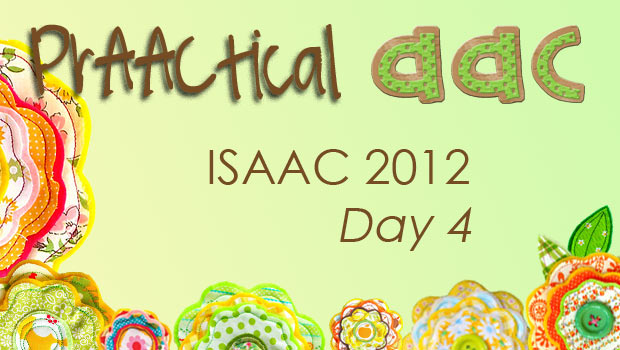
Lots more ISAAC fun to tell about in Day 4! — My day started with a shorter version of the presentation on the preschool core language curriculum that I’m working on with Lori Wise. You can see the handout for that presentation here. — There is some fascinating work going on in the area in supporting the emotional development of children with AAC needs. Dr. Sarah Blackstone and colleagues talked about the developmental sequence in which emotional competence emerges. They are working on an observation and interview tool used to collect information on a child’s emotional development and the caregiver strategies. They are planning a pilot study with the tool they are developing and actively looking for volunteers to use this tool with children who are developmentally between 12 months and 10 years. – Terry Foss and and Jane Korsten did an interesting presentation called Promptology 101 where they reviewed some... [Read More...]








